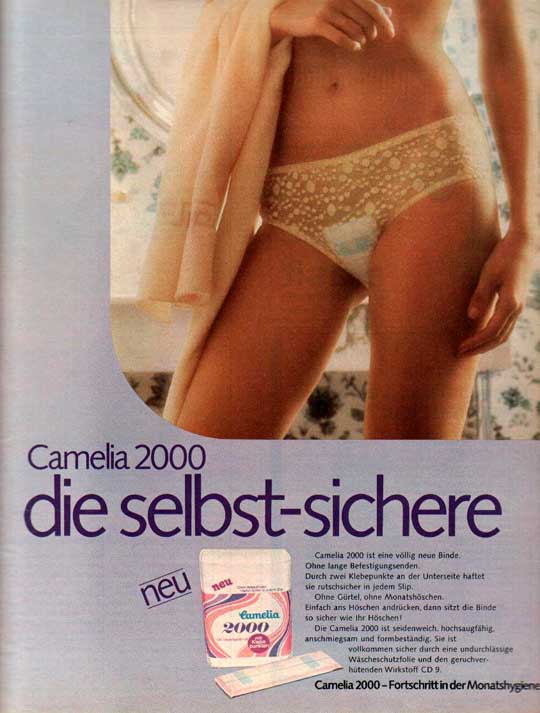More Camelia ads:
1920s (Germany), 1930s
(Germany), 1940/42
(Germany, with underpants made from sugar sacks,
1945/46), 1952
(Australia), 1970s
(France), 1990
(Germany) - Underpants
directory
Booklets menstrual
hygiene companies made for girls, women and
teachers - patent
medicine - a list
of books and articles about menstruation - videos
See a Kotex ad
advertising a Marjorie May booklet.
See many more similar booklets.
See ads for
menarche-education booklets: Marjorie May's Twelfth
Birthday (Kotex, 1932), Tampax
tampons (1970, with Susan Dey), Personal Products
(1955, with Carol Lynley), and German o.b. tampons (lower
ad, 1981)
And read Lynn Peril's series
about these and similar booklets!
Read the full text of the 1935 Canadian edition
of Marjorie May's Twelfth Birthday, probably
identical to the American edition.
More ads for teens (see also introductory page for
teenage advertising): Are
you in the know?
(Kotex napkins and Quest napkin powder, 1948,
U.S.A.), Are
you in the know?
(Kotex napkins and belts, 1949, U.S.A.)Are you in the know? (Kotex napkins, 1953, U.S.A.),
Are you in the know? (Kotex napkins and belts,
1964, U.S.A.), Freedom
(1990, Germany), Kotex (1992, U.S.A.), Pursettes (1974, U.S.A.), Pursettes (1974, U.S.A.), Saba (1975, Denmark)
See early tampons
and a list of tampon
on this site - at least the ones I've cataloged.


|

Camelia adhesive menstrual napkin ad
(Monatsbinde), Germany,
May 1973
The small text in the ad (below) I
think makes the case that the adhesive
menstrual pad, or Monatsbinde in
German, is one
of the big advances for women in the
20th century (my
translation):
Camelia 2000
is a completely new pad.
Without long attachment ends [see
example here].
Two sticky points on the under
side attach the pad to any panties
without slipping.
Without belt [American example], without special
panties [Monatshöschen,
"Monthly panties" - see German and American pairs]
Simply press into the panties and
the pad will stay as safely as
your panties do!
The Camelia 2000 is soft as silk,
highly absorbent, hugs the body
and retains its shape. It's
completely safe through an
impenetrable shield and the
odor-stopper substance CD 9.
Camelia 2000
- Progress in menstrual hygiene
The headline
reads,
Camelia 2000
the self-securing

Menstrual pads
that had a sticky surface for
adhesion into panty crotches first
appeared in the U.S.A., in the very
early 1970s: Stayfree (here) and New Freedom (here), both product
names emphasizing freedom. Before
then, women using pads had to wear a
belt or special panties - or pin
them to their underpants. That's why
tampon boxes and ads exclaimed, "No
belts, no pins" (here). A whole industry
collapsed when adhesive pads
appeared.
More Camelia ads:
1920s
(Germany), 1930s
(Germany), 1940/42
(Germany, with underpants made from
sugar sacks, 1945/46), 1952
(Australia), 1970s
(France), 1990
(Germany) - Underpants
directory
|
© 2006 Harry Finley. It is illegal to
reproduce or distribute any of the work on this
Web site in any manner or
medium without written permission of the author.
Please report suspected violations to hfinley@mum.org
|